2022 Kia EV6 electric car is a hoot, and it hits reset for the brand
In the broad shift toward electric vehicles, full-line automakers like Kia face a dilemma: Do they look to heritage and nostalgia? Do they install the new tech under the hood and move on? Or are EVs the chance for a complete reset on multiple levels?
Looking at Kia, it’s essentially the latter. As the first of many EVs from the brand to be built on the modular E-GMP platform shared with Hyundai and Genesis, the EV6 is a clean-slate vehicle that doesn’t look like anything else in the brand’s current or past lineup. Unlike its nouveau-synth Hyundai Ioniq 5 cousin, there’s zero nostalgia in play. Here it’s all about the future.
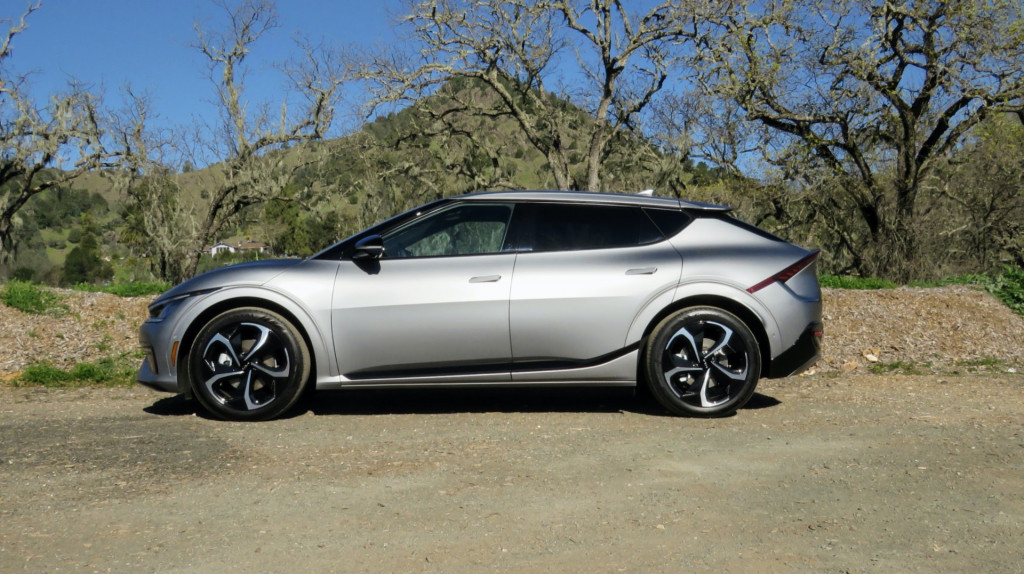
2022 Kia EV6 GT-Line
Just like the extroverted Stinger sport-hatchback that arrived in 2017 and the handsome Telluride SUV that followed it in 2019, the EV6 has serious panache—a just-right size, a near-premium feel inside, and a look that will have you turning around, repeatedly, at each stop, to try to size up exactly what this sexy-looking thing is you’re driving.
Enigmatic shape, clear mission
All else is different though. The EV6 has a supercar snout, combined with an aero-focused rear treatment that looks like it belongs on a Euro-chic hatchback. The profile is very low-set from some paces away, and it gives out hot-hatch vibes on approach. But once you’re up next to it, the proportions can confound. The EV6 has the exact same wheelbase as the Telluride, and it’s just 0.2 inch shorter in wheelbase than the Stinger. And with a length of 184.2 inches and an overall width of 74.0 inches, its dimensions wraps right in with the Tesla Model Y, Volkswagen ID.4, Ford Mustang Mach-E, or Hyundai Ioniq 5. But at less than 61 inches high overall—several inches shorter than the rest of those models—the EV6 just looks longer, lower, more grounded. And that’s a good thing.
Just like the Ioniq 5, it’s classified as a passenger car in U.S. parlance—a Small Station Wagon in this case, versus the Ioniq 5’s Large Car. Although dimensions between the models are virtually identical, the Ioniq 5’s greater height helps buy it three more cubic feet of passenger volume. The EV6’s minimum ground clearance also falls into the car category, with about 2.5 inches less than your typical Subaru—although with its approach angle of 15.4 degrees, you won’t be minding delicate chin spoilers at every driveway.
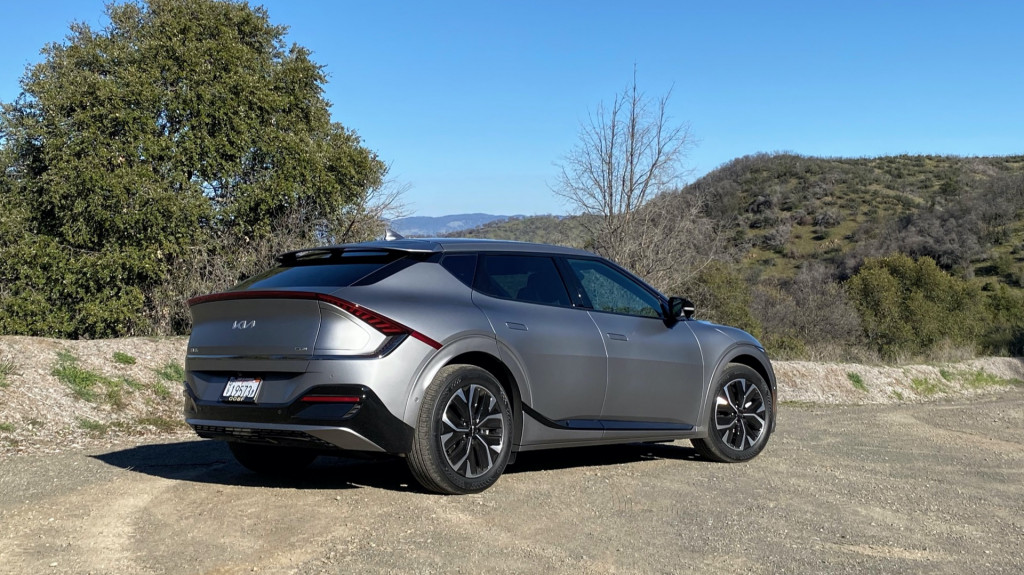
2022 Kia EV6 GT-Line
We’ve just returned from a first-drive opportunity with the EV6 in Northern California, and Kia chose a route that would do the Stinger proud—with lots of tight corners, heaving road surfaces, and unpredictably banked turns. The EV6 handled it all fantastically, and now we have a clear picture of how well it might be able to handle all the extra power of the GT model, on the way later this year with 576 hp and a 0-60 mph time of less than 3.5 seconds.
That route gave the EV6’s suspension more of a workout than the Ioniq 5 got in a more smoothly surfaced circuit last month; the Kia feels just a bit more firmly sprung than its Hyundai counterpart—almost certainly with less body lean, potentially at the expense of ride quality.
Fun and fast—despite the comfortably numb steering
Dynamically, the EV6 is a hoot. The steering feels rather numb and doesn’t convey any road feel from the tires, but that’s about the only nit to pick. It tracks well on the highway and feels precise as you load up around a tight corner. And it feels delightfully balanced even as you approach the tires’ limits, with the impression that the center of mass is just under the driver’s seat.
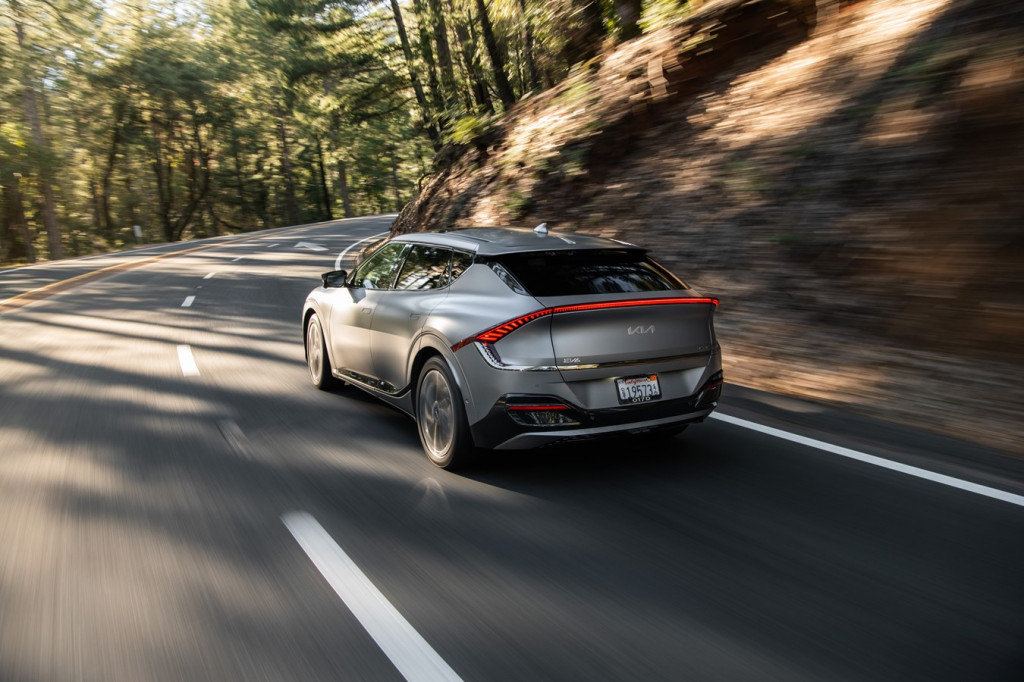
2022 Kia EV6
There’s a pretty significant difference between how the dual-motor all-wheel drive versions ride and handle, compared to the single-motor rear-wheel drive versions. At 4,661 lb for the loaded GT-Line AWD I first drove, followed by 4,255 lb for the GT-Line RWD, ride quality is part of it, and the RWD felt like it kept its composure over pavement heaves far better than the AWD. The way the RWD model is calibrated, I got to enjoy it more as it was far more comfortable sliding its tail out ever slightly in very tight corners, while the AWD version would take more bravery (and track time, perhaps) to get the power to the front to help pull tighter around a curve. Both are fun, just in different ways.
The EV6 is very quiet inside, with pavement and wind noise well hushed—although after driving them both essentially back-to-back I will note that motor whine is more present in the AWD version.
In Wind or GT-Line trims, the EV6 is available with single-motor (rear-wheel-drive) or dual-motor (all-wheel-drive) configurations, both with a 77.4-kwh battery pack. They yield 225 hp and 258 lb-ft of torque, and 320 hp and 446 lb-ft, respectively. Base Light versions of the EV6 will arrive a bit later in the year, with a smaller 58-kwh battery pack. They’ll make 167 hp and 258 lb-ft of torque from their single-motor system.
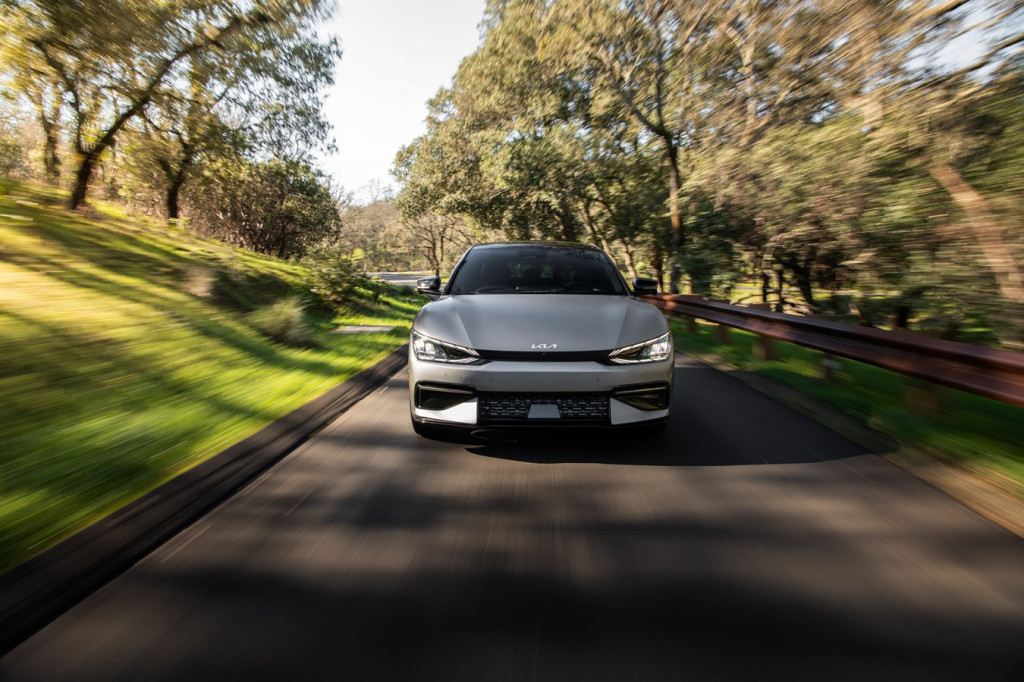
2022 Kia EV6
For the two big-pack models I drove, 0-60 mph times run at under five seconds (4.6 by Kia’s officially cited independent result from AMCI) for the AWD, and between six and seven seconds for the RWD. It’s a difference you can feel, for sure, but the single-motor model still feels quick.
Real-world range looks really good
EPA-rated range with the larger pack and rear-wheel drive spans up to 310 miles, with all-wheel-drive versions rated at 274 miles. Light versions with the smaller pack are rated 232 miles.
Since I started and ended the drive day at the same place, I was able to get a weighted average over a drive route of nearly 150 miles, including four drive legs: 3.4 miles per kwh across two top-trim GT-Line models, with about 55 miles in the all-wheel-drive GT-Line and about 95 miles in the rear-wheel-drive GT-Line. The route didn’t allow any comparisons between the two on efficiency, as I was ascending during most of the route with the AWD and descending during most of the time with the RWD. Outside temperature spanned from 53 degrees to 64 degrees, so the battery packs were getting close to their likely sweet spot.
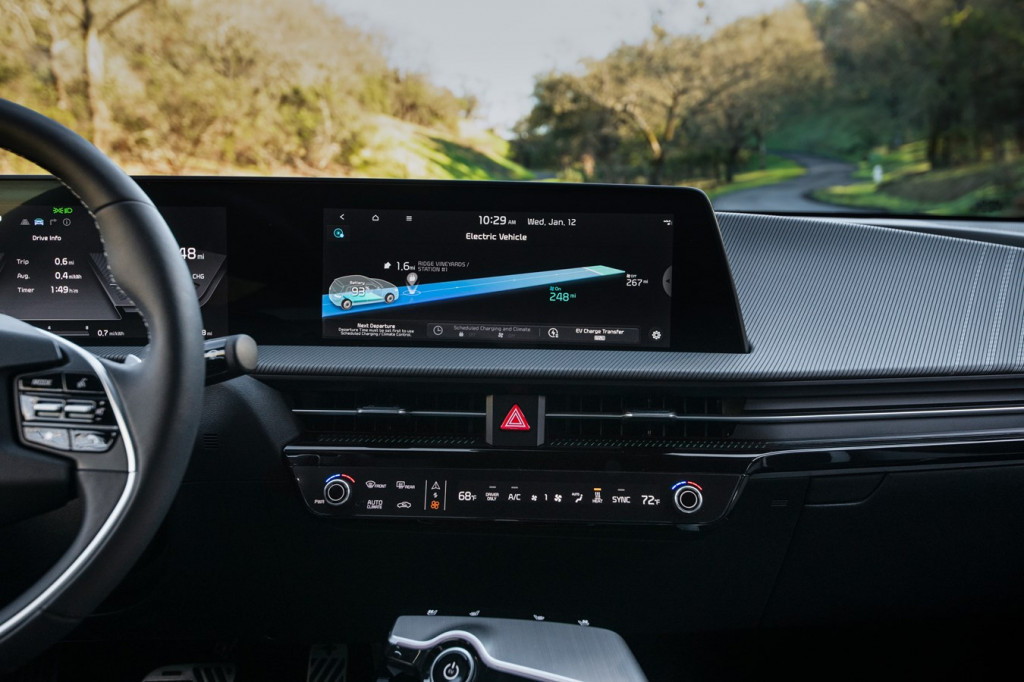
2022 Kia EV6
At the end of the drive, my test car showed its 38{e3fa8c93bbc40c5a69d9feca38dfe7b99f2900dad9038a568cd0f4101441c3f9} remaining equating to 114 miles of remaining range—suggesting with these far-from-efficient driving styles a total range of 300 miles.
That happens to be exactly what the single-motor, big-pack EV6 is rated, in terms of EPA combined efficiency—so with this I have a relatively high level of certainty owners are going to do much better than this in the real world.
Heat pump + dog clutch = more miles
The EPA cycle omits two useful range-extending technologies on dual-motor AWD models, however—which may bring their real-world efficiency much closer to that of single-motor RWD versions. One of them is the heat-pump system included with those dual-motor models, helping to boost efficiency significantly in some cold-weather driving. The other is a dog-clutch arrangement that mechanically disconnects the front motor more or less, depending on the mode, to provide up to a 6{e3fa8c93bbc40c5a69d9feca38dfe7b99f2900dad9038a568cd0f4101441c3f9} range increase. In Normal mode the system reverts to rear-wheel-drive under light loads for efficiency, while Eco mode runs without the front motor in all but launches. Sport mode keeps a dynamic split between front and rear, while a Snow mode locks in a 50/50 torque split for traction and dials back regenerative braking.

2022 Kia EV6
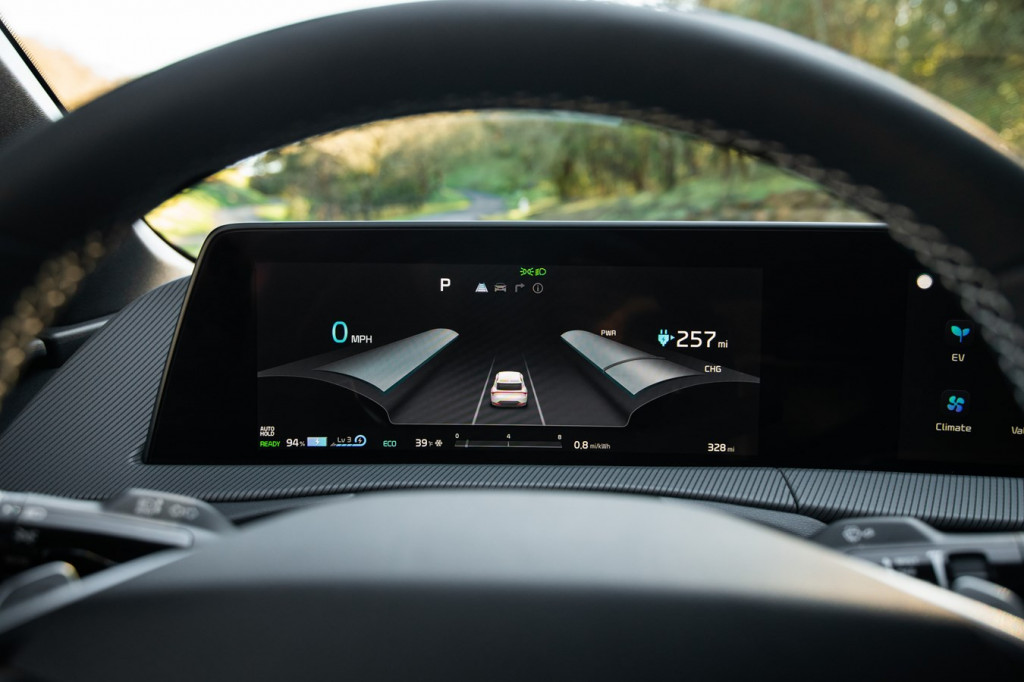
2022 Kia EV6
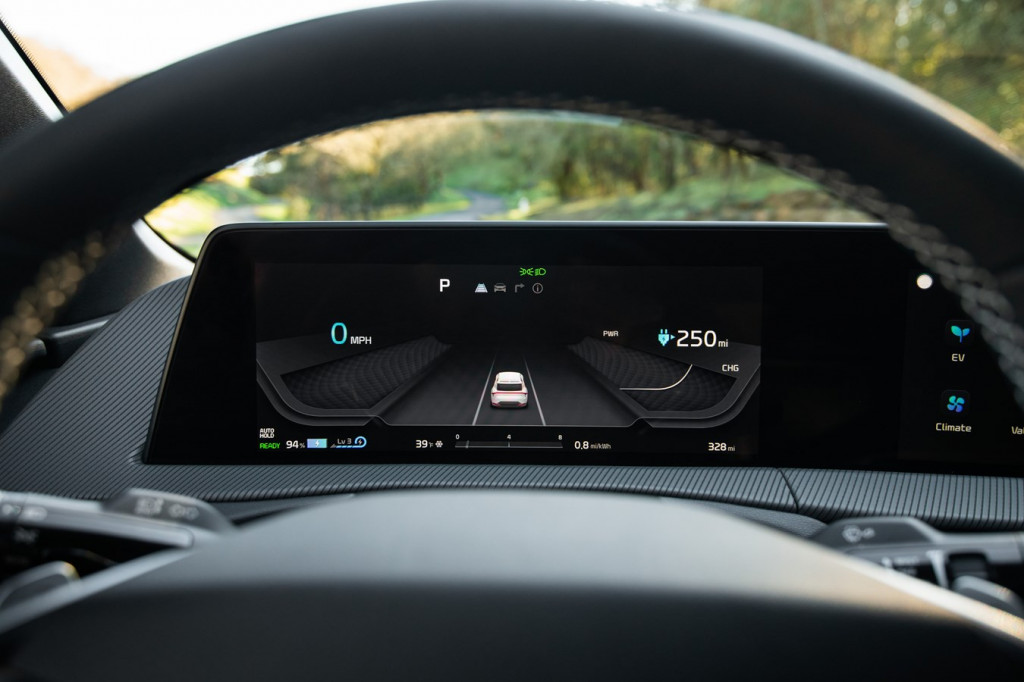
2022 Kia EV6
Across all but Snow mode, you can use the steering-wheel paddles to select between the default Level 1 (light regen) to Level 0 (coasting) in one direction, or to stronger Level 2 or Level 3 regen in the other direction, on to an I-Pedal mode that’s essentially one-pedal driving. Separately there’s an Auto mode that takes into account the pace of traffic. Regenerative braking isn’t all that different between single- and dual-motor cars; that’s because with the more efficient silicon carbide inverter in back, the system prioritizes energy recovery at those wheels most of the time, as possible with traction.
Front seats in the EV6 are comfortable and supportive, although just as we observed in the Ioniq 5, the swoopier roofline suggests a lower seat point than the interior provides; the seats’ H-point—where your hips sit—is higher than some taller drivers will want or need. At 6-foot-6, my head was just an inch or so from the enclosure for the sunroof (more of a transitional sunroof here), which is included in all U.S. versions, although I fit in the back seats just fine with more space above my head.
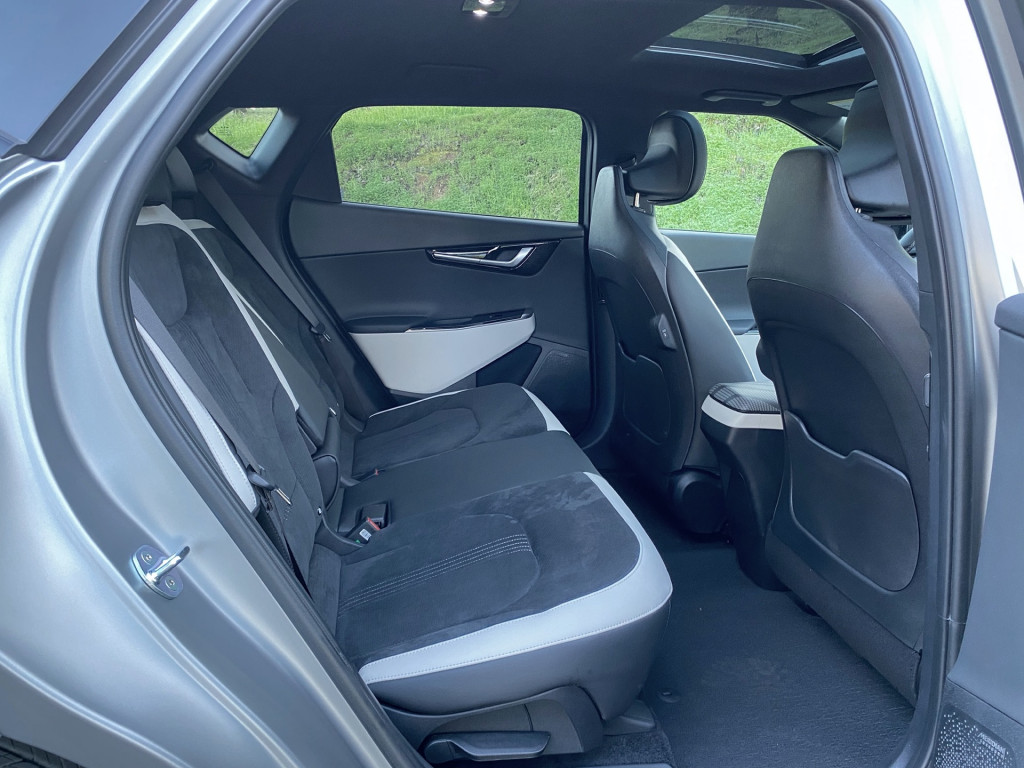
2022 Kia EV6 GT-Line
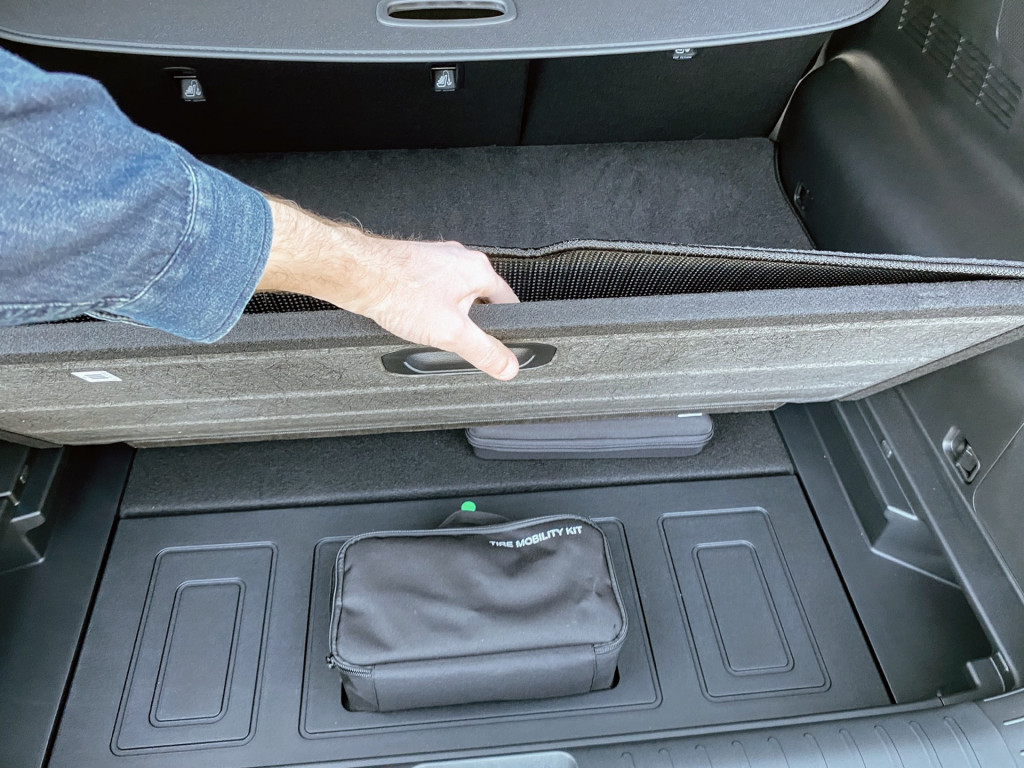
2022 Kia EV6 GT-Line
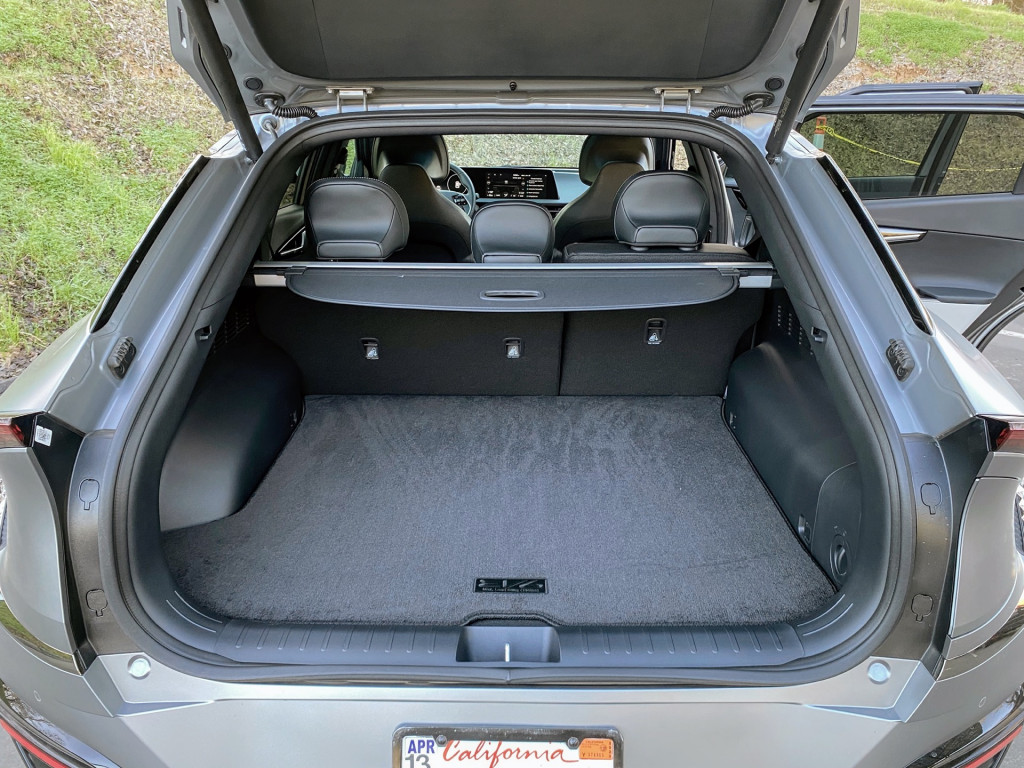
2022 Kia EV6 GT-Line
The 2022 EV6 offers 24.4 cubic feet of cargo space behind the rear seats—with an additional compartment under the cargo floor in back. The cargo space is boosted to 50.2 cubic feet with those seatbacks folded forward. There’s also a deep compartment in the center console (which doesn’t slide fore and aft as in the Ioniq 5), plus a frunk with a small plastic suitcase-sized compartment atop what feels like a traditional engine bay without the engine.
Styling short of a breakthrough inside
The styling within the EV6 cabin succeeds in setting the right ambience for the mission, but there are a few disconnects. It feels a bit like Kia had to take what Hyundai penned in and just move on with it. You get a version of the Ioniq 5’s console without the sliding—with the shift selector and some added climate switches at the front of it—plus the upright, all-on-one-plane, side-by-side 12.3-inch screens, without the Ioniq 5’s upright dash to frame the layout. They stand atop an otherwise curvaceous dash in the EV6 looking a bit orphaned and walking a middle ground between cockpit layout and something more open. It’s hard to imagine Kia didn’t have a more cohesive sketch.

2022 Kia EV6 GT-Line
Visual differences between the model levels are mostly limited to wheels, trim, and upholstery. Base Light models include 19-inch wheels and matte-black trim, while mid-level Wind versions come with V2L capability and are distinguished by their gloss-black trim. In AWD versions they add a heat pump and heated steering wheel. A Tech Package on the Wind AWD adds remote park assist, surround-view and blind-spot monitors, and a parking collision avoidance system. At the top of the line, the GT-Line has a sportier look, with suede and vegan leather plus a head-up display. AWD versions of the GT-Line add the heat pump and heated steering wheel plus heated rear seats.
The Kia Connect telematics service that comes with the EV6 includes up to five years of complimentary remote services, apps for phones and smartwatches, wifi hotspot capability, and its own voice commands. The infotainment system can get over-the-air updates for mapping and some other screen-based feature functionality, but as of yet the EV6 can’t get over-the-air updates for safety or propulsion systems.
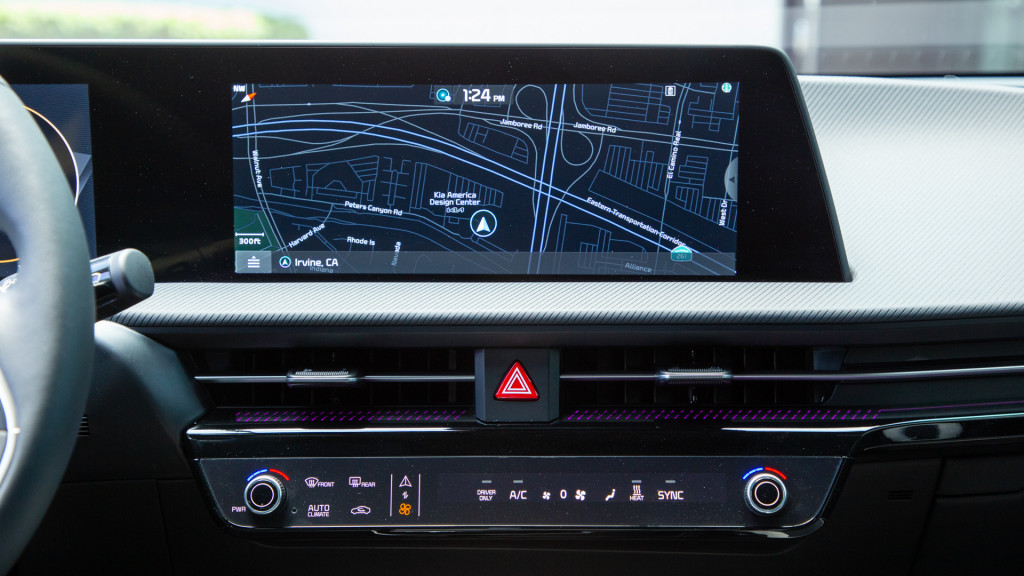
2022 Kia EV6
All versions have two 12.3-inch screens side by side, with a display-only screen in front of the driver and a touchscreen atop the middle of the dash. Just below it is a separate touch panel that can flip its set of “virtual” buttons between navigation and climate functions, while basic climate buttons are always visible.
The so-called augmented reality head-up display projects navigation directions as well as active-safety system prompts and warnings into the driver’s windshield view. I found the directional blind-spot alerts to be very useful and intuitive.
The pack is essentially the same as the one used in the Hyundai Ioniq 5, and for the larger pack, Kia cites a Level 2 charge time from 10{e3fa8c93bbc40c5a69d9feca38dfe7b99f2900dad9038a568cd0f4101441c3f9} to 100{e3fa8c93bbc40c5a69d9feca38dfe7b99f2900dad9038a568cd0f4101441c3f9} at 7 hours, 10 minutes (40-amp). On a 350-kw CCS-format DC fast-charger, the EV6 can add nearly 70 miles of range in less than five minutes, or get from 10{e3fa8c93bbc40c5a69d9feca38dfe7b99f2900dad9038a568cd0f4101441c3f9} to 80{e3fa8c93bbc40c5a69d9feca38dfe7b99f2900dad9038a568cd0f4101441c3f9} in under 18 minutes—with charge rates that peak at more than 225 kw. Kia doesn’t precondition the battery for fast-charging, and it only warms the battery in extreme cold.
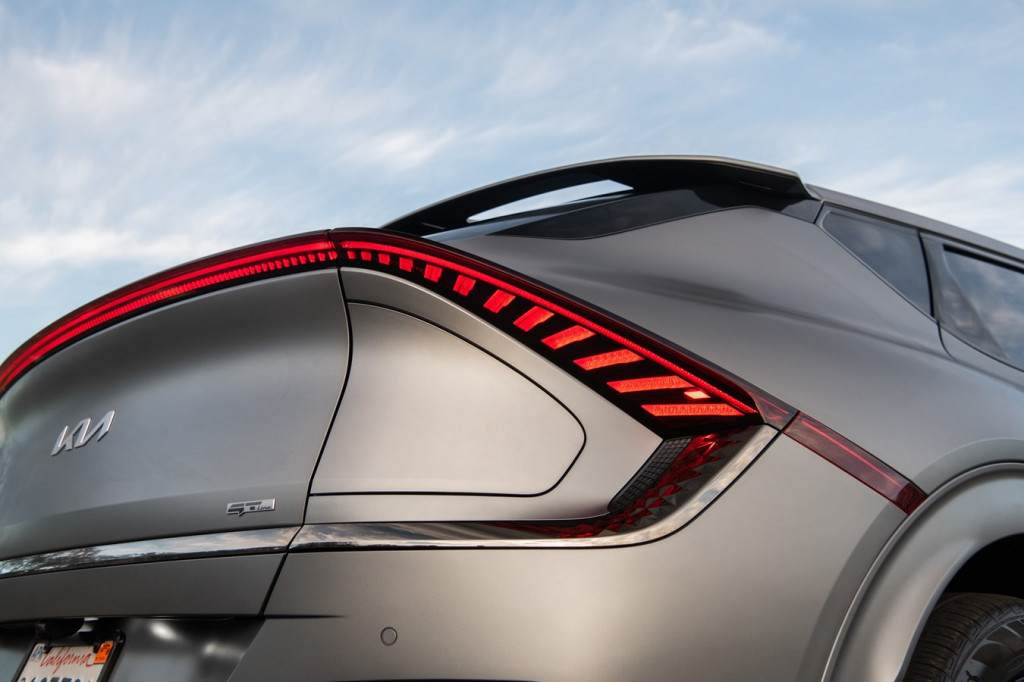
2022 Kia EV6
On all but the Light model, a Vehicle to Load function will output 1.9 kw of power good for projects, camping, or recreational equipment. It can also charge other vehicles, Kia points out, and can draw power for 36 hours or more.
Kia casting a wider net
Unlike Hyundai, with its Hyundai Home ecosystem soon promising home energy storage, coordination with solar, and more, Kia has no plans as of yet for home-energy hardware, a standalone EV sub-brand, or other accessories for taking advantage of that V2L capability.
Our biggest disappointment with the Ioniq 5—and seriously, one of the things holding it back from our Best Car To Buy contention—was its limited availability. Kia has a completely different plan with the EV6; it aims to offer the EV6 in all 50 states—to the extent that it’s aiming to send a first EV6 to the majority of its 750+ dealerships right now, with some deliveries starting before it airs ads featuring the car on Super Bowl Sunday on February 13.
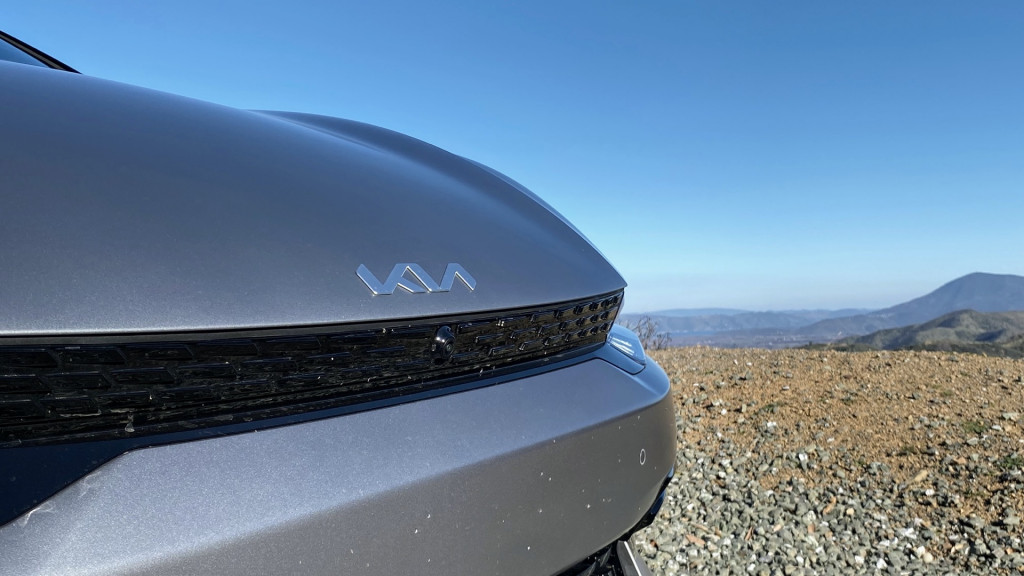
2022 Kia EV6 GT-Line
The EV6 isn’t trying to be an extension of pony-car heritage. It isn’t aiming for nostalgia. It isn’t arriving amid lofty sales targets that were set before it was developed. It’s just setting the stage for what Kia will do much more of in the near future. And it’s excellent.
–
Internet Brands accepted meals and lodging plus some transportation in order to facilitate this review.